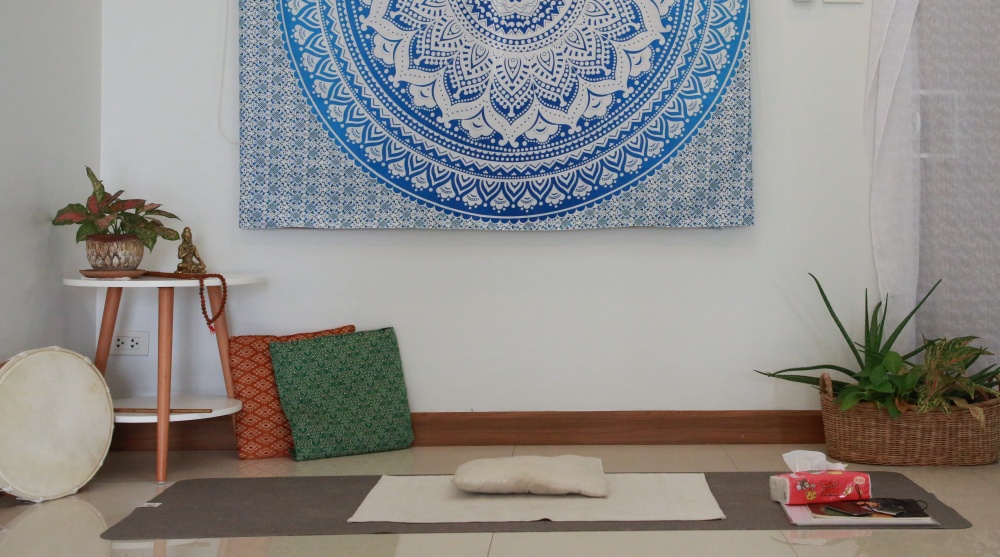WHAT IS MEANT BY SADHANA?
The word Sadhana / Sadhna means: “a methodical discipline to attain desired knowledge or spiritual goal”. In other words it is a daily spiritual practice.
This practice can include a variety of disciplines that come from Yoga, Energy work, Self-development, Self-improvement, and spiritual traditions like Hinduism, Buddhism or Sikhism.
Sadhana is done for attaining a higher level of awareness and consciousness. It is done for a level of spiritual realization, detachment from ego, to gain liberation and enlightenment.
This daily routine keeps you anchored to your higher self and higher purpose, which means you can live and thrive rather than being bounced around by your external world and the whims of your thought and emotions.
A sadhana is a practice that you yourself are actively involved in. It is about commitment, discipline and action.

WHEN TO PRACTICE SADHANA
Sadhanas are usually done first thing in the morning on waking.
An advanced practitioner will use the ambrosial hours in which to perform their sadhana. The ambrosial hours are the 2 & 1/2 hours before the sun rises. The ambrosial hours are the time of day where the veil of illusion is thinnest. This time of day is very high in pure Prana (energy). This makes practice easier and more effective as you can go much deeper into yourself and your practice.
If you are just starting out it is perfectly okay to practice your sadhana anytime after waking up. In the beginning it is more important that you do a practice rather than worrying about getting up early to do the practice.
As you get used to the habit of a morning practice, later on you can work on waking up a little bit earlier to do your sadhana.
Sometimes you may need to add a practice in during your day or even in the evening. All is acceptable.
TYPES OF SADHANA
A sadhana is any activity that will quieten the ego, remove limitations that are holding you back, help you take control of your mind, help you understand your unique way of existence in this world and help you open yourself up to higher levels of conscious experience.
These are activities like meditation, asanas (conscious body positions or movements), chanting, singing, breathwork, being in nature, writing in a journal, prayer, devotion, affirmations, mindfulness, visualization, working with divination tools or working with your spiritual guides.
Everyone has a unique way of connecting to their higher spiritual self, so what works for one person does not necessarily work for another. If you find that sitting in silence in meditation is impossible, don’t feel like you are failing, try something else. Maybe you work better with a Vinyasa Yoga sequence, or some Qi Gong, or maybe chanting or journaling is perfect for you.

Once you have discovered your spiritual medicine; work with it daily.
Working with it means putting in the time, dedication and practicing every day. Committing 100% (or at least the best of your ability) to the practice without distraction.
Progressing yourself in the practice as when is necessary. This can be done by waking earlier, increasing your time spent in a practice, adding another component to the practice, or increasing the challenge level.
A sadhana should not be forced into an outcome. Although the final experience from daily practice is liberation and enlightenment, trying to force this or make this happen is not how sadhana works.
Trying to reach the outcome or a specific goal is failing to understand the sadhana. The journey and the act of doing is more important than the outcome. When you let go of things having to arrive or end up a certain way you will find your sadhana is easier to do, more enjoyable and will fast track to levels you could not even begin to fathom. We like to term this act of letting go and trusting – Grace.
HOW MANY DAYS TO BE EFFECTIVE?
Practitioners of Kundalini Yoga choose to practice for a minimum of 40 consecutive days.
A Kriya, meditation, chant or pranayama can be done longer up to 120 or even 1000 days.
According to Phillippa Lally; a health psychology researcher at University College London, a new habit usually takes 66 days to up to 254 days until it’s an automatic habit.

The benefit of doing practice for the long haul is that you fully experience what the sadhana has to offer. The sadhana may seem simple and basic on the surface, but they are packed with a wealth of spiritual information and wisdom. You can only tap into this through daily long term practice.
The other reasons why practitioners chose to practice a particular sadhana for this long is that you unravel loads of information about yourself through the consistent practice.
When the daily sadhana becomes a routine or good habit it means that on those days that you feel tired or unmotivated.…you’ll end up doing your sadhana anyway. This in itself helps you cope with whatever you are going through.
40 to 120 to 1000 days helps to discipline the mind, especially the negative mind. The practice strengthens your intuition, makes you aware of your energy and energy around you. You become heightened to subtleties. The practice heals the body, releases blocks and limitations. It releases you from the grips of your ego. The practice connects you to universal higher consciousness.
HOW TO DO SADHANA
Here are some suggestions for creating your Sadhana:
1. Set your alarm for the same time every morning.
When your alarm goes off, get up immediately. Over time you will not even need the alarm clock and you will wake at the same time each morning.
2. Create a space that you come to every morning.
This space is dedicated to your Sadhana practice only. Don’t use this space for anything else besides spiritual practice. This space is your personal space for you and you only.

3. Make your Sadhana space a special, safe, sacred space.
It can be filled with things that inspire you, remind you of your spiritual practice, or that make you feel safe and comfortable.
For example: incense, candles, crystals, tarot cards or oracle cards, mandalas, plants, pictures that inspire you, quotes, books that uplift you, cushions, a shawl, a journal, musical instruments, objects from nature….. it’s your special space so make it special. You want to feel that you can be at ease and able to fully experience yourself in this space, so make it a safe and sacred space that you can do this in.
Once you have woken, been to the bathroom and had a glass of water go immediately to your Sadhana space and practice.
SADHANA IDEAS

1. Practice 3 to 5 minutes of Ego Eradicator or Sat Kriya.
2. Pranayama (breathing practice) 5 to 20 minutes. For example: deep full breathing, focusing on the movement of the breath at the nostrils. OR Alternate nostril breathing.
3. Stretch your body in whatever way seems necessary. Do this mindfully connecting your breath to the stretch.
4. Choose a Kundalini Yoga kriya / meditation to follow. Here is a link to free Kriyas & Meditations on my YouTube channel.
5. Choose your favourite mantra and chant it for 5 to 30 minutes.
6. Join an early morning group live or on-line or do by yourself. Examples: Aquarian Sadhana / Yoga / Thai Chi / Qi Gong / Meditation /Etc.
7. Go for a walk in nature, focusing on your breath, your footsteps and nature itself. Take your time. Don’t rush this.
8. Select a tarot card / oracle card / inspirational quote / spiritual philosophy idea. Read it, contemplate over it, meditate on it.
9. Listen to motivational affirmations in areas you want improvement on…. a form of self-hypnosis.
10. Meditate.
Blog written by Nicola (Sita Amrit Kaur) February 2021
Edited March 2022
Ready to expand your consciousness?
Ready to release those blocks that have kept you stuck?
In a transition and wanting to know how to navigate it?
There is no time like NOW to do the work on yourself!
Join the 1 Month integrative program.



